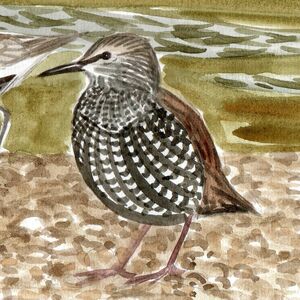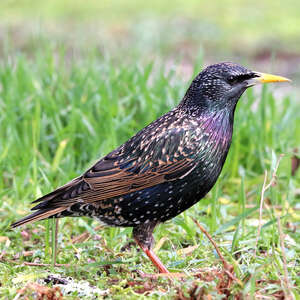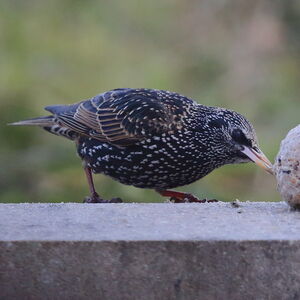Common Starling
Sturnus vulgaris - Étourneau sansonnet
Identification
The Common Starling is a black bird slightly smaller than the Blackbird with whom it can be confused, but its silhouette is different. The tail is quite short and barely protruding the large wings while resting, whereas the blackbird has short wings and a long tail. The difference is visible while flying as one can appreciate the shape of its wings, pointed and wide at base, similar to triangular. Moreover, flying is very different. The plumage is black and shiny whereas the male blackbird has a dull one. The adult plumage, just after the autumn moult is characterized by black feathers with paler tips (white, cream or even reddish), which gives to the bird a mottled appearance. During the course of wearing these feathers throughout winter, the patches will fade progressively to give way to a glossy black nuptial plumage, with green or lilac reflections depending the place. But there will always remain some traces breaking the uniformity of the plumage, especially in female. The flight feathers and greater coverts are edged with cream or fawn. At the same time, the beak and legs, which were dark at the time of moult, take colour. It is at this level that a slight sexual dimorphism can be seen : reproductive male has yellow beak with bluish base while in female the base is rosy. Moreover, the male's legs have a brighter pinkish-red colour than the female's. He also has more ornamental feathers around the throat which shows well while singing. The female's iris is slightly paler. But everything works towards the adults being in their finest attire during spring for reproduction. The juvenile is very different in looks to the point that one often mistakes it for another species. Its plumage is entirely brown-gray and quite clear.
The uniformity is simply broken by the chamois edges of the wing feathers. The beak is blackish with a yellow commissure. The legs are reddish or brownish.
Subspecific information 13 subspecies
- Sturnus vulgaris vulgaris (most of Europe)
- Sturnus vulgaris caucasicus (Caucasus to s Iran)
- Sturnus vulgaris faroensis (Faroe Is.)
- Sturnus vulgaris zetlandicus (Shetland Is.)
- Sturnus vulgaris granti (Azores)
- Sturnus vulgaris poltaratskyi (se European Russia to w Mongolia)
- Sturnus vulgaris tauricus (Ukraine, sw Russia and Turkey)
- Sturnus vulgaris purpurascens (e Turkey, Georgia and Armenia)
- Sturnus vulgaris oppenheimi (se Turkey and n Iraq)
- Sturnus vulgaris nobilior (ne Iran, s Turkmenistan and Afghanistan)
- Sturnus vulgaris porphyronotus (e Kazakhstan and nw China to Uzbekistan and Tajikistan)
- Sturnus vulgaris humii (w Himalayas)
- Sturnus vulgaris minor (c and s Pakistan)
Foreign names
- Étourneau sansonnet,
- Estornino pinto,
- estorninho-malhado,
- Star,
- seregély,
- Spreeuw,
- Storno,
- stare,
- Stær,
- škorec obyčajný,
- špaček obecný,
- Stær,
- kottarainen,
- Europese Spreeu,
- estornell comú,
- Stari,
- szpak (zwyczajny),
- mājas strazds,
- škorec,
- Скворец,
- ホシムクドリ,
- 紫翅椋鸟,
- นกกิ้งโครงพันธุ์ยุโรป,
- 歐洲椋鳥〔紫翅椋鳥〕,
Voice song and call
The Common Starling is an extremely vocal bird all year round. This is related to its very gregarious nature, with individuals in a group keeping a permanent contact. The repertoire is very varied and almost untranslatable. Different cries are numerous, the most classic being a prolonged tchrrrriiiiii. We can also hear an heinnnn of distress near the nest or powerful tenk in the presence of a predator such as the sparrowhawk. Young in the nest beg incessantly with srrii srrii srrii. The song is a long phrase made of various whistles alternating with more melodic syllables. Grating and discordant notes, trills and runs punctuate the phrases. It includes imitations of very many species, passerines and non-passerines. A classic imitation, for example, is that of the oriole's song, which can deceive the novice. But it also gladly imitates the buzzard, coot, etc.
Habitat
The Common Starling has two requirements for nesting. It needs open environments for foraging on the ground, and cavities for reproduction.
Behaviour character trait
The main behavior of the Common Starling is its gregarious temperament, which leads it to form groups almost throughout the year. It is only during the nesting period that it adopts a territorial behavior towards its congeners, but this territory is barely marked and allows nearly colonial reproduction in the most favorable areas. Even during nesting, the adults that are not in the nest join communal dormitories for protection from predators. As soon as chicks escape from the nest, families gather together, feed together and spend the night in dormitories.
The Common Starling is very terrestrial when it feeds. It actively searches its insect prey on the ground with a rapid step, combing the surface with its beak. On the contrary, during the fruit season, it can feed directly on trees or bushes, often in groups. This makes it considered very harmful in vineyards or orchards, especially cherry orchards. During the reproduction period, males are very demonstrative for the possession of cavities and the attraction of females. The song is emitted from a visible perch, from where they can easily be seen, with a typical gesticulation, including movements of its open wings, a swelling of the throat raising ornamental feathers, and of course the mentioned vocalizations. The introduction of the species in North America, with the increasing number of birds and their aggressive behavior, caused the decline of other species nesting in cavities. The Common Starling is often near Man. During the interseason, it can become a real nuisance due to its noises and feces on the urban resting places.Flight
The flight of the Common Starling is energetic, swift and direct. The flapping of wings is very rapid and continuous.
Small glides occur before the landing. When it looks for food on the ground, it also flies in small, short bursts so it can reach favourable places the fastest way possible. Groups of migrants fly rapidly, usually at a low altitude. But what is the most spectacular among this species are the flights in groups, especially the acrobatics which take place before their descent at the roosting place. Groups, which can be made of thousands of birds, glide in the sky forming dense clouds, which move, zigzag, change direction instantaneously, in an amazing way. To be able to accomplish collective acrobatics with instant direction changes, it implies cognitive capacities and inter-individual visual communication. The role of the cerebellum is very important. In the presence of predators like the sparrowhawk, starlings in flight get closer together. We say they form the ball. It is a good sign for the attentive birdwatcher who can then also detect the predator.Dietfeeding habits
Common Starling is an omnivore species, but its insectivore diet is the most predominant throughout all seasons.
Their preys come from arthropods (insects, myriapods, arachnids), but also earthworms and small mollusks. An ideal prey example are dipteran tipulidae and their land larvae, which are ubiquitous in the meadows, both on the surface and at low depth. Therefore the beak is a fundamental tool. Young are feed with animal preys. Such preys have to be sought on the mudflats, both in marine environment, which is very rich in arthropods, and in continental environment in drained ponds, both places in which these birds coexist with more specialised species like shorebirds. From summer to winter, fruits take a big importance in the diet, which can cause problem for viticulture and arboriculture. An extreme case happens in the Mediterranean area, especially in Maghreb, where, in winter, huge flocks of this species gather in the olive tree orchards. Locally, people may blow up the roosts using explosives in order to get rid of them, with all the collateral damages one may think of, without any real solution, given the natural dynamics of this species. Other food sources for Common Starling are artificial, such as waste disposal sites providing the bird with human food waste all year round, or agricultural farms, which are visited for manure and silage.Reproduction nesting
The Common Starling nests in cavities. Height is indifferent to it, although it prefers higher cavities. In forests, it inhabits old woodpecker dwellings. Due to its size, it can fit into those of the most common species everywhere, the Eurasian Great Spotted Woodpecker. The ones of the Black Woodpecker are too big for it. For cavity occupancy, it is dominant against other potential species such as tits, nuthatches and other flycatchers. In a humanised environment, any sufficiently confined and protected cavity from predators can be occupied. The nest is very often placed under a roof edge when the shingle has a hole, for example.
In recent decades, it has adapted to modern street lights, making its nest behind the bulbs which also provide a pleasant atmosphere. Boxes can be occupied, of course, but not those reserved for tits or other small passerines which have an exit hole too small, except if it has been enlarged by the Great Spotted Woodpecker. It will prefer a box for barn owls, rollers or hoopoes, so it is in competition. The nest is made of very diverse materials, the interior being lined with soft elements such as dry grasses, vegetable and animal fibers, moss, feathers, sometimes paper or string, etc. From the end of March or the beginning of April in the south of its range, the female lays 4 or 6 intensely blue eggs without spots. The deep color is linked to cave nesting, the eggs being invisible to predators. Most of the incubation is done by the female who takes 15 days. The young ones leave the nest at about three weeks old and the parents still feed them for a few days more. As soon as they emancipate, the gregarious behaviour takes over and the families gather for their activities. If the nest is destroyed, the couple can start a replacement clutch, but with a smaller number of eggs and probably less success in the end.Behaviorally speaking, the species displays some peculiarities. Even though it's far from being the rule, males can be polygynous. Nest parasitism has also been noted. For example, a female may take an egg from a foreign nest and replace it with her own.Geographic range
The Common Starling reproduces from the Atlantic, including its islands (Ireland, British Isles, Azores, Madeira and Canaries), to the heart of the Eurasian continent around Lake Baikal, at temperate latitudes, up to the taiga in the north. Spain is only occupied in the far northwest because the species is in competition with its vicar, the Spotless Starling. It gives its place to the spotless starling in Corsica. To the southeast, its range extends to Asia Minor then to Iran, the south of Central Asia, northern Pakistan and the northeast of the Indian continent. The species is partially migratory. The most northern populations join the temperate regions in winter, the Mediterranean biome to the west and subtropical lands to the east (the Persian Gulf coast, the south of Pakistan and the north half of the Indian continent). The Starling has been introduced, voluntarily or not, to several places in the world. And since it is very adaptable, it is now well established in North America where it is still progressing and causing the same problems as in Europe, but also in Argentina, the south of Africa, Australia, New Zealand, etc.
Threats - protection
IUCN conservation status
concern
in the Wild
threatened
evaluated
Common Starling is a very common species, often increasing in number and absolutely not threatened. It does not need any particular protection. It is more perceived as a predator, which it often is due to its proximity to man and its activities, without seeing its beneficial role as a consumer of insects and other pests. In any case, if we want to counteract its negative impact, it is better to prioritize prevention over destruction, if only from an ethical point of view.
Sources of information
- IOC World Bird List (v15.1), Gill, F and D Donsker (Eds). 2025-12-07.
Other sources of interest
 Specification sheet created on
06/07/2023 by Jean François
Specification sheet created on
06/07/2023 by Jean FrançoisTranslation by AI Oiseaux.net
© 1996-2026 Oiseaux.net
- Accipitriformes
- Aegotheliformes
- Anseriformes
- Apodiformes
- Apterygiformes
- Bucerotiformes
- Caprimulgiformes
- Cariamiformes
- Casuariiformes
- Charadriiformes
- Ciconiiformes
- Coliiformes
- Columbiformes
- Coraciiformes
- Cuculiformes
- Eurypygiformes
- Falconiformes
- Galliformes
- Gaviiformes
- Gruiformes
- Leptosomiformes
- Mesitornithiformes
- Musophagiformes
- Nyctibiiformes
- Opisthocomiformes
- Otidiformes
- Passeriformes
- Pelecaniformes
- Phaethontiformes
- Phoenicopteriformes
- Piciformes
- Podargiformes
- Podicipediformes
- Procellariiformes
- Psittaciformes
- Pterocliformes
- Rheiformes
- Sphenisciformes
- Steatornithiformes
- Strigiformes
- Struthioniformes
- Suliformes
- Tinamiformes
- Trogoniformes


































